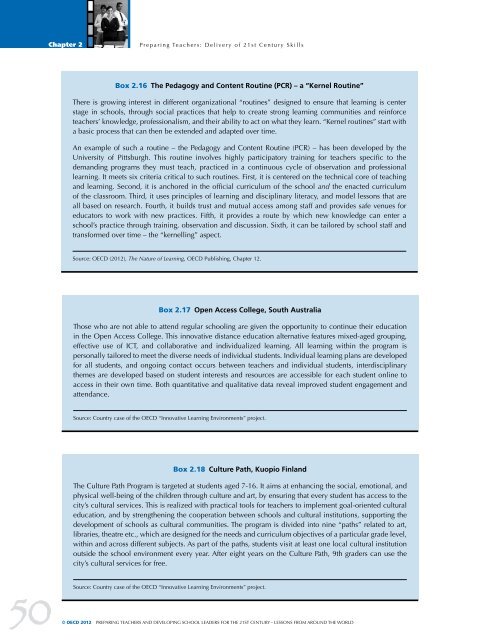Preparing Teachers and Developing School Leaders for the 21st Century
Preparing Teachers and Developing School Leaders for the 21st Century
Preparing Teachers and Developing School Leaders for the 21st Century
You also want an ePaper? Increase the reach of your titles
YUMPU automatically turns print PDFs into web optimized ePapers that Google loves.
50 ©<br />
Chapter 2<br />
<strong>Preparing</strong> teachers: delivery of <strong>21st</strong> century skills<br />
Box 2.16 The Pedagogy <strong>and</strong> Content Routine (PCR) – a “Kernel Routine”<br />
<strong>the</strong>re is growing interest in different organizational “routines” designed to ensure that learning is center<br />
stage in schools, through social practices that help to create strong learning communities <strong>and</strong> rein<strong>for</strong>ce<br />
teachers’ knowledge, professionalism, <strong>and</strong> <strong>the</strong>ir ability to act on what <strong>the</strong>y learn. “Kernel routines” start with<br />
a basic process that can <strong>the</strong>n be extended <strong>and</strong> adapted over time.<br />
an example of such a routine – <strong>the</strong> Pedagogy <strong>and</strong> content routine (Pcr) – has been developed by <strong>the</strong><br />
university of Pittsburgh. this routine involves highly participatory training <strong>for</strong> teachers specific to <strong>the</strong><br />
dem<strong>and</strong>ing programs <strong>the</strong>y must teach, practiced in a continuous cycle of observation <strong>and</strong> professional<br />
learning. it meets six criteria critical to such routines. first, it is centered on <strong>the</strong> technical core of teaching<br />
<strong>and</strong> learning. second, it is anchored in <strong>the</strong> official curriculum of <strong>the</strong> school <strong>and</strong> <strong>the</strong> enacted curriculum<br />
of <strong>the</strong> classroom. third, it uses principles of learning <strong>and</strong> disciplinary literacy, <strong>and</strong> model lessons that are<br />
all based on research. fourth, it builds trust <strong>and</strong> mutual access among staff <strong>and</strong> provides safe venues <strong>for</strong><br />
educators to work with new practices. fifth, it provides a route by which new knowledge can enter a<br />
school’s practice through training, observation <strong>and</strong> discussion. Sixth, it can be tailored by school staff <strong>and</strong><br />
trans<strong>for</strong>med over time – <strong>the</strong> “kernelling” aspect.<br />
source: oecd (2012), The Nature of Learning, oecd Publishing, chapter 12.<br />
Box 2.17 Open Access College, South Australia<br />
those who are not able to attend regular schooling are given <strong>the</strong> opportunity to continue <strong>the</strong>ir education<br />
in <strong>the</strong> open access college. this innovative distance education alternative features mixed-aged grouping,<br />
effective use of ict, <strong>and</strong> collaborative <strong>and</strong> individualized learning. all learning within <strong>the</strong> program is<br />
personally tailored to meet <strong>the</strong> diverse needs of individual students. individual learning plans are developed<br />
<strong>for</strong> all students, <strong>and</strong> ongoing contact occurs between teachers <strong>and</strong> individual students, interdisciplinary<br />
<strong>the</strong>mes are developed based on student interests <strong>and</strong> resources are accessible <strong>for</strong> each student online to<br />
access in <strong>the</strong>ir own time. Both quantitative <strong>and</strong> qualitative data reveal improved student engagement <strong>and</strong><br />
attendance.<br />
source: country case of <strong>the</strong> oecd “innovative learning environments” project.<br />
Box 2.18 Culture Path, Kuopio Finl<strong>and</strong><br />
<strong>the</strong> culture Path Program is targeted at students aged 7-16. it aims at enhancing <strong>the</strong> social, emotional, <strong>and</strong><br />
physical well-being of <strong>the</strong> children through culture <strong>and</strong> art, by ensuring that every student has access to <strong>the</strong><br />
city’s cultural services. This is realized with practical tools <strong>for</strong> teachers to implement goal-oriented cultural<br />
education, <strong>and</strong> by streng<strong>the</strong>ning <strong>the</strong> cooperation between schools <strong>and</strong> cultural institutions, supporting <strong>the</strong><br />
development of schools as cultural communities. <strong>the</strong> program is divided into nine “paths” related to art,<br />
libraries, <strong>the</strong>atre etc., which are designed <strong>for</strong> <strong>the</strong> needs <strong>and</strong> curriculum objectives of a particular grade level,<br />
within <strong>and</strong> across different subjects. as part of <strong>the</strong> paths, students visit at least one local cultural institution<br />
outside <strong>the</strong> school environment every year. after eight years on <strong>the</strong> culture Path, 9th graders can use <strong>the</strong><br />
city’s cultural services <strong>for</strong> free.<br />
source: country case of <strong>the</strong> oecd “innovative learning environments” project.<br />
OECD 2012 PreParing teachers <strong>and</strong> develoPing school leaders <strong>for</strong> <strong>the</strong> <strong>21st</strong> century – lessons froM around <strong>the</strong> World


